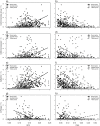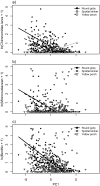Species identity matters when interpreting trophic markers in aquatic food webs
- PMID: 30289888
- PMCID: PMC6173397
- DOI: 10.1371/journal.pone.0204767
Species identity matters when interpreting trophic markers in aquatic food webs
Abstract
In aquatic systems, food web linkages are often assessed using diet contents, stable isotope ratios, and, increasingly, fatty acid composition of organisms. Some correlations between different trophic metrics are assumed to be well-supported; for example, particular stable isotope ratios and fatty acids seem to reflect reliance on benthic or pelagic energy pathways. However, understanding whether the assumed correlations between different trophic metrics are coherent and consistent across species represents a key step toward their effective use in food web studies. To assess links among trophic markers, we compared relationships between major diet components, fatty acids, and stable isotope ratios in three fishes: yellow perch (Perca flavescens), round goby (Neogobius melanostomus), and spottail shiner (Notropis hudsonius) collected from nearshore Lake Michigan. Yellow perch and spottail shiner are native in this system, while round goby are a relatively recent invader. We found some evidence for agreement between different trophic metrics, especially between diet components, n-3:n-6 fatty acid ratios, and stable isotope ratios (δ13C and δ15N). However, we also observed significant variation in observed relationships among markers and species, potentially due to taxonomic variation in the specific diet items consumed (e.g., chydorid microcrustaceans and Dreissena mussels) and species-specific biochemical processes. In many of these latter cases, the invasive species differed from the native species. Understanding the effects of taxonomic variation on prey and predator signatures could significantly improve the usefulness of fatty acids in food web studies, whereas diet contents and stable isotopes appear to be reliable indicators of trophic niche in aquatic food webs.
Conflict of interest statement
The authors have declared that no competing interests exist.
Figures








References
-
- West JM, Williams GD, Madon SP, Zedler JB. Integrating spatial and temporal variability into the analysis of fish food web linkages in Tijuana Estuary. Environ Biol Fishes. 2003;67: 297–309. 10.1023/A:1025843300415 - DOI
-
- McMeans BC, McCann KS, Tunney TD, Fisk AT, Muir AM, Lester N, et al. The adaptive capacity of lake food webs: from individuals to ecosystems. Ecol Monogr. 2016;86: 4–19. 10.1890/15-0288.1 - DOI
-
- Gu B, Schelske CL, Hoyer MV. Stable isotopes of carbon and nitrogen as indicators of diet and trophic structure of the fish community in a shallow hypereutrophic lake. J Fish Biol. 1996;49: 1233–1243. 10.1111/j.1095-8649.1996.tb01792.x - DOI
Publication types
MeSH terms
Substances
LinkOut - more resources
Full Text Sources

